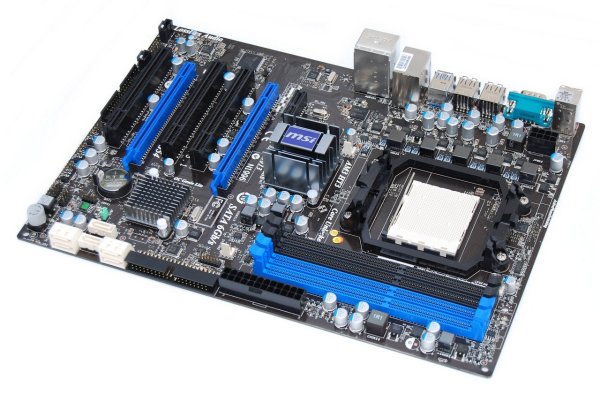MSI 870A-G54 – Design
The MSI 870A-G54 feature set is a bit bland and its board design is no different. While there is nothing really wrong with the layout of the 870A-G54, it is a rather boring motherboard on the surface, especially when compared to the Asrock and Gigabyte products that sell in the same price range.


Despite its plain appearance MSI claims that the 870A-G54 is one of their military-class products using Hi-c CAP solid state capacitors, Icy Choke and Solid CAP capacitors. Server grade Hi-c CAP solid state capacitors feature a rare element Tantalum at their core. They offer high temperature durability and stability, making them ideal for harsh, high temperature environments (overclocking, anyone?). They claim a lifecycle more than 8 times longer than solid state capacitors.

The Icy Choke is said to effectively reduce operating temperature by 20°C, among other things that cannot be accurately tested by us. Then we have the Solid CAP capacitors which use high polymer aluminum improving their resistance to heat.
While the use of all these quality components is welcome, it is hard to put a price on their value. For the most part they can be considered marketing hype. Still, we will be testing the overclocking performance of the MSI 870A-G54 in just a minute to see what this motherboard is really made of.

The 870A-G54 features a basic 4+1 power phase design like the Asrock 880GMH/USB3, though it is said to feature better quality components as we mentioned above. The power circuitry has been left naked without any form of cooling, just as we found on the Asrock and Gigabyte motherboards.

The AMD 870 north bridge chip features the smallest heatsink of all three motherboards, while the SB850 south bridge heatsink is fairly standard. All in all, the cooling setup is very basic, though given the power requirements of the chipset it should fit the job well.

In terms of expansion the MSI 870A-G54 features a single PCI Express x1 slot, three traditional PCI slots and two full length PCIe x16 slots. Similar to Gigabyte's board, the secondary PCIe x16 port is only wired for x4 bandwidth, which means Crossfire is likely to suffer a performance hit when using this AMD 870 motherboard.

The SATA ports located behind the PCIe x16 slots have been mounted at a 90-degree angle to avoid any space conflicts with longer graphics cards. That said, two of the six ports are not mounted at the 90-degree angle, and while this won't cause any issues, some might prefer a unified design here.

Finally, around at the I/O panel we are faced with a limited number of connectivity options. There is a single PS/2 port, six USB 2.0 ports, two USB 3.0 ports, Ethernet, Serial port, S/PDIF Out and six audio jacks. When compared to the Asrock and Gigabyte boards this is a fairly weak lineup even though the essentials have been covered.